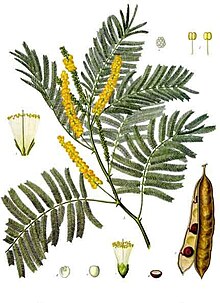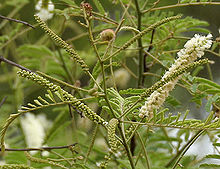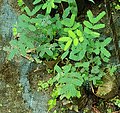Senegalia catechu
| Senegalia catechu | |
|---|---|

| |
| Scientific classification | |
| Kingdom: | Plantae |
| Clade: | Tracheophytes |
| Clade: | Angiosperms |
| Clade: | Eudicots |
| Clade: | Rosids |
| Order: | Fabales |
| Family: | Fabaceae |
| Subfamily: | Caesalpinioideae |
| Clade: | Mimosoid clade |
| Genus: | Senegalia |
| Species: | S. catechu
|
| Binomial name | |
| Senegalia catechu (L.f.) P.J.H.Hurter & Mabb.
| |
| Varieties | |
| |

| |
| Range of Senegalia catechu | |
| Synonyms[2] | |
| |

Senegalia catechu is a deciduous, thorny tree which grows up to 15 m (50 ft) in height.[3] The plant is called khair [4] in Hindi, and kachu in Malay, hence the name was Latinized to "catechu" in Linnaean taxonomy, as the type-species from which the extracts cutch and catechu are derived.[5] Common names for it include kher,[6] catechu, cachou, cutchtree, black cutch, and black catechu.
Senegalia catechu is found in parts of South Asia and Southeast Asia, including Cambodia, India, Myanmar, Thailand and Indonesia[2]

Through derivatives of the flavanols in its extracts, the species has lent its name to the important catechins, catechols and catecholamines of chemistry and biology.
Uses[]
Food[]

The tree's seeds are a good source of protein.[7] Kattha (catechu), an extract of its heartwood, is used as an ingredient to give red color and typical flavor to paan. Paan is an Indian and Southeast Asian tradition of chewing betel leaf (Piper betle) with areca nut and slaked lime paste.
Fodder[]
Branches of the tree are quite often cut for goat fodder and are sometimes fed to cattle.[2][7][8]
Folk medicine[]
The heartwood, bark, and wood extract (called catechu) are used in traditional medicine.[3][9] The concentrated aqueous extract, known as khayer gum or cutch, is astringent.[10]
Wood[]

The tree is often planted for use as firewood and charcoal and its wood is highly valued for furniture and tools.[3] The wood has a density of about 0.88 g/cm3.[11]
Other uses[]
Its heartwood extract is used in dyeing and leather tanning, as a preservative for fishing nets, and as a viscosity regulator for oil drilling.[3] Its flowers are a good source of nectar and pollen for bees.
Cultivation[]

The tree can be propagated by planting its seeds, which are soaked in hot water first. After about six months in a nursery, the seedlings can be planted in the field.[3]


Plantlings

Acacia catechu plantlings
See also[]
- Arid Forest Research Institute
- Catechu
- Catechin
- Pyrocatechol
References[]
- ^ hear.org
- ^ a b c International Legume Database & Information Service (ILDIS)
- ^ a b c d e www.fao.org
- ^ www.haryana-online.com Archived 2011-02-03 at the Wayback Machine
- ^ http://www.yourdictionary.com/catechu Derivation of word from Malay
- ^ Ujwala, T. K.; Tomy, Shawn; Celine, Sandra; Chander, J. Sam Johnson Udaya (2015). "A Systematic Review of Some Potential Anti-Diabetic Herbs Used in India Characterized by Its Hypoglycemic Activity". International Journal of Pharmaceutical Sciences and Research. 6 (12): 4940–4957. ProQuest 1747402306.
- ^ a b World AgroForestry Database
- ^ Heuzé V., Tran G., Hassoun P., Lebas F., 2018. Black cutch (Senegalia catechu). Feedipedia, a programme by INRA, CIRAD, AFZ and FAO. https://www.feedipedia.org/node/354 Last updated on February 9, 2018, 13:20
- ^ "Plant Details". envis.frlht.org. Retrieved 2014-10-04.
- ^ British Pharmacopoeia, Department of Health, British Pharmacopoeia Commission, London. The Stationery Office, (1999)
- ^ FAO Appendix 1
External links[]
 Media related to Senegalia catechu at Wikimedia Commons
Media related to Senegalia catechu at Wikimedia Commons Data related to Acacia catechu at Wikispecies
Data related to Acacia catechu at Wikispecies Media related to Senegalia catechu at Wikimedia Commons
Media related to Senegalia catechu at Wikimedia Commons
- Senegalia
- Flora of Asia
- Plants used in Ayurveda
- Trees of Nepal
- Plant dyes




